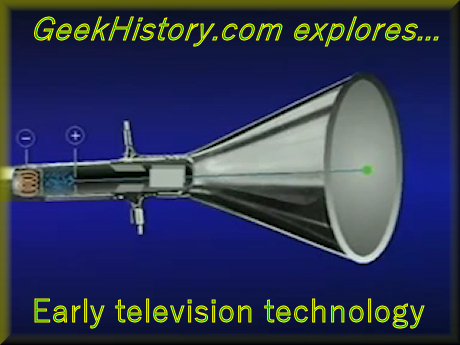 As we look at the history of television, I wanted to tackle some of the frequently asked questions about the origins of the technology, as well as share some cool resources on movies and television.
As we look at the history of television, I wanted to tackle some of the frequently asked questions about the origins of the technology, as well as share some cool resources on movies and television.
One commonly asked question is why the early televisions had round screens. The television picture tube was a vacuum tube that contains one or more electron guns and a phosphorescent screen used to display images known as a cathode ray tubes (CRT). When the original cathode ray tube was invented it was an experimental device, television was not yet developed. The natural shape of the cathode ray tube was round, as shown here in the diagram. The cheapest and easiest way to manufacture a CRT was to make it round.
The television picture is created on the surface of the cathode ray tube by drawing it rapidly line by line. The entire front area of the CRT is scanned repetitively and systematically in a fixed pattern. Before 1940 there was no standard in the United States for how the picture was created electronically using the cathode ray tube.
In 1940 the Federal Communications Commission (FCC) established The National Television System Committee (NTSC) to resolve the conflicts that were made between companies over the introduction of a nation wide analog television system in the United States. The NTSC standard selected 525 scan lines, an aspect ratio of 4:3, and frequency modulation (FM) for the sound signal. The number of 525 lines was chosen as a because of the limitations of the vacuum-tube-based technologies of the day.
Why an aspect ratio of 4:3?
The term aspect ratio is used in many fields to describe the proportional relationship between width and height, expressed as two numbers separated by a colon. For example when we say that the early televisions had an aspect ratio of 4:3, that means they are 4 units wide and 3 units high. The early television standard of the 4:3 aspect ratio was chosen because movies in that era were filmed in a 4:3 aspect ratio. Movies originally photographed on 35 mm film could be satisfactorily viewed on early televisions.
Motion pictures, a series of still images which, when shown on a screen, creates the illusion of moving images, or as we sometimes call them, movies, are a different field from television. But the early days of motion pictures actually set the standard for the concept of aspect ratio, the relationship of height to width of an image. For many years the standard movie screen, as well as the standard analog television, had an aspect ratio of 4:3.
The evolution of round screens to rectangular
The cheapest and easiest way to manufacture a CRT was to make it round. But the aspect ration of 4:3 lends itself to a more rectangular design. The CRT slowly evolved to being essentially rectangular in shape but it had rounded edges because it was a glass tube. You could not create a perfect rectangle using the process that created the glass cathode ray tubes in the early days of television.If you look at the photo of various televisions you see a variety of screen sizes as well as shapes, and you can see the evolution of round screens to rectangular. The attached photograph was taken at the National Capital Radio and Television Museum, a cool little geek history museum located in Bowie, Maryland. It is a small house jam-packed with displays on the history of radio and television. The extremely knowledgeable staff was full of stories about everything on display and ready to answer any question. The museum does a great job of preserving technology history.
Increasing the number of channels
During the 1940s and the 1950s broadcast television stations in the United States were primarily transmitted on the VHF band, channels 2-13. If you live in a large city you will notice the long established stations usually are lower numbered. Television manufacturers like RCA, ran their own networks, such as NBC. Since the major TV networks were well-established on VHF, many smaller stations on the UHF band, channels 14 to 83, were struggling for survival. Fourth-network operators such as the DuMont Television Network were forced to expand using UHF channels due to a lack of available VHF channels.
In 1961 the United States Congress passed the All-Channel Receiver Act (ACRA) to allow the Federal Communications Commission to require that all television set manufacturers must include UHF tuners. All new TV sets sold after 1964 had built-in UHF tuners. The All-Channel Receiver Act allowed the UHF TV stations to grow and eventually would outnumber the long established VHF stations.
What happened to Channel 1?
When I was young, and the television had a rotary dial that took me from channels 2 through 13, I always wondered, what happened to channel 1? In 1948, Channel 1 frequencies were deleted from those allocated to television use and given over completely to radio services. The FCC decided not to renumber the channels since many televisions were being made using the existing channel numbers.
History of Television resources
If you want to learn more about television, from the perspective of the appliance that sits in your living room, rather than from the broadcasting side, there is a great pair of videos by RCA. Reasons Why, The (Part I) (1959) and Reasons Why, The (Part II) (1959) are two videos that can be watched online or downloaded for later viewing.
Reasons Why, The (Part I) https://archive.org/details/reasons_why_1
Reasons Why, The (Part II) https://archive.org/details/reasons_why_2
Classic scenes of geeks from the 1950s showing various facets of television set design, engineering, and quality control. The RCA manufacturing videos are part of a section of the Internet Archive known as the Prelinger Archives, a collection of over 60,000 advertising, educational, industrial, and amateur films.
Created in 1992 primarily to document the history of the Cathode Ray Tube it does a nice job of illustrating the basic concept of the CRT. It also includes a bit of television history showing the evolution of the CRT.
Cathode Ray Tube https://archive.org/details/KF.BraunCathodeRayTube
A propaganda infomercial by RCA to brag about what they have done in the world of television. Not the most historically accurate account of television, but still a very interesting bit of geek history.
Story of Television Published 1956 https://archive.org/details/Story_of_Television_The
Free online movies great digital library
Spending a Saturday morning at the Internet Archives (archive.org) is like going to the library or your favorite museum, and the best part about it is that you don't need to leave the comfort of your home computer desk.
All of the video files can be viewed for free online, and many are available to be downloaded and viewed offline. The Internet Archive does a decent job of making sure copyrights are not violated. Most of the files are public domain, but some may occasionally have some restrictions for use and are marked as to how they may be used. Because copyright laws have changed from time to time over the years, many of the files are considered public domain, or copyright free, for a variety of reasons.
The Internet Archive does a decent job of making sure copyrights are not violated. Most of the files are public domain, but some may occasionally have some restrictions for use and are marked as to how they may be used. Because copyright laws have changed from time to time over the years, many of the files are considered public domain, or copyright free, for a variety of reasons. All of the video files can be viewed for free online, and many are available to be downloaded and viewed offline.
